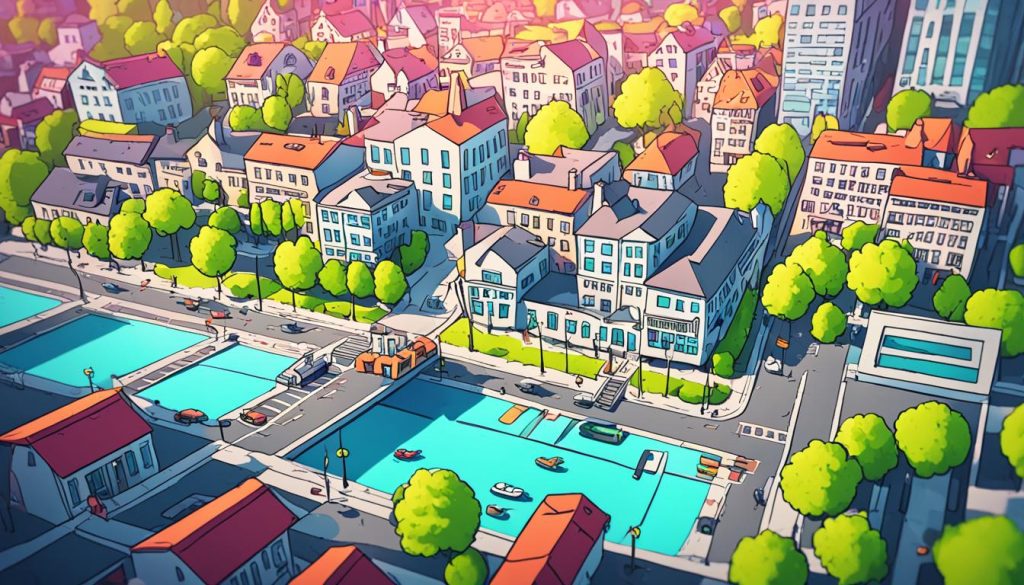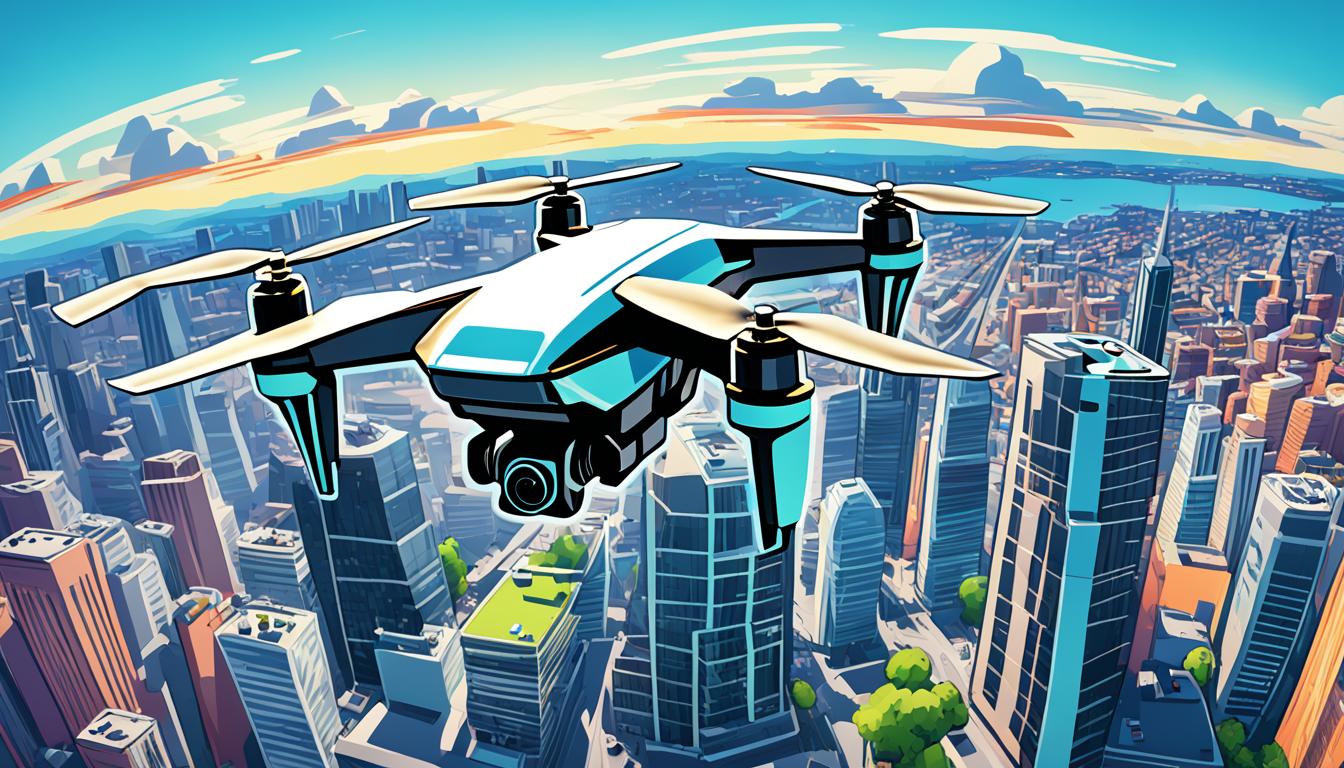You can make your hyperlapse drone footage smooth and professional-looking in post-production. Use special software and techniques for this. It’s key to making your drone videos look great.
Editing hyperlapse footage often means fixing shaky or uneven shots. With stabilization and color correction, you can turn your drone shots into beautiful scenes.
Video post-production helps fix issues like drifting in hyperlapse shots. Tools like Adobe Premiere, After Effects, and Lightroom have features to fix camera movements and perspective shifts.
Learning these post-production skills can take your drone videos to the next level. You’ll create hyperlapse sequences that grab attention in aerial cinematography.
Understanding Hyperlapse Drone Footage
Hyperlapse drone footage is a special kind of video that adds a new level to drone videos. It mixes time-lapse with drone movement. This creates amazing visuals that make time and space seem to move fast.
What is hyperlapse photography?
Hyperlapse photography takes many still photos while the camera moves. These photos are then put together to make a fast video. When done with drones, it makes incredible aerial videos.
Challenges in drone hyperlapse creation
Creating hyperlapse drone videos has its challenges. It’s important to keep the drone flying straight and the camera steady. Changes in view and height can mess up the video. Wind and other things can also make the drone move too much.
Importance of post-production in hyperlapse
Post-production is key to making hyperlapse drone videos great. It helps fix camera shake, lighting issues, and changes in view. Through editing, you can make the video flow better, adjust colors, and improve the overall look.
| Aspect | Importance in Hyperlapse | Post-Production Solution |
|---|---|---|
| Camera Stability | Critical for smooth movement | Stabilization software |
| Lighting Consistency | Ensures uniform look | Color correction tools |
| Perspective Changes | Maintains visual continuity | Frame alignment techniques |
To make amazing hyperlapse drone videos, focus on these key areas. Remember, getting good at this takes practice and patience. With these tips, you can take your drone videos to the next level.
Essential Equipment and Software for Hyperlapse Editing
To make amazing hyperlapses and improve your drone footage, you need the right tools. Let’s look at the key equipment and software for editing your projects.
Start with a strong computer that has lots of RAM and storage. This helps with smooth editing, especially for high-resolution videos. A fast processor and a dedicated graphics card make rendering faster.
For enhancing drone footage, Adobe Lightroom is a great choice. It’s great for color correction and basic tweaks. After Effects and Premiere Pro are top picks for putting sequences together and stabilizing footage. They have advanced features for making professional hyperlapses.
| Software | Key Features | Best For |
|---|---|---|
| Adobe Lightroom | Color correction, basic adjustments | Initial image processing |
| Adobe After Effects | Advanced stabilization, motion graphics | Complex hyperlapse projects |
| Adobe Premiere Pro | Video editing, color grading | Assembling sequences, final output |
DaVinci Resolve is another strong choice, with great color grading tools. For Mac users, Final Cut Pro offers a smooth editing experience. These options suit different skills and project needs.
The complexity of your edit and your footage’s resolution will guide your hardware and software choices. Investing in quality gear and software will improve your hyperlapse videos and make editing easier.
Preparing Your Footage for Post-Production
Getting ready for post-production is key in your drone cinematography workflow. It lays the groundwork for easy editing and makes your hyperlapse footage stand out. Let’s look at the main steps to prepare.
Importing and Organizing Image Sequences
Begin by bringing your images into a software like Adobe Lightroom for photo management. Make a new catalog for your project and sort your shots into folders by location or scene. This makes your workflow smoother and helps you find shots easily later.
Choosing the Right File Format
Picking the right file format is crucial for quality in editing. RAW files give you the most flexibility but take up more space. JPEGs are smaller but limit what you can edit. Think about your project and what you can handle when choosing.
| File Format | Pros | Cons |
|---|---|---|
| RAW | High quality, more editing flexibility | Large file size, longer processing time |
| JPEG | Smaller file size, faster processing | Limited editing options, potential quality loss |
Creating Backups
Before editing, back up your original footage. Use external hard drives or cloud storage to keep your work safe. This step prevents data loss and lets you start over if needed. A good backup plan is crucial for drone cinematography.
Color Correction Techniques for Hyperlapse Sequences
Color correction is key in making hyperlapse videos look great. It makes sure your footage looks consistent and visually appealing. Let’s dive into some top techniques to boost your hyperlapse project.

Begin by picking the first image in your sequence. Adjust the exposure, white balance, and colors to get the look you want. This sets the base for the rest of your sequence.
Then, make a preset with your changes. Use this preset on all images in your hyperlapse. This makes editing faster and keeps the look consistent.
After setting the preset, check the middle and end frames. Look for any lighting changes or inconsistencies. Make small tweaks as needed for a smooth flow between frames.
For fast edits or posts for social media, using the same preset on all images works well. This method makes editing quicker and still looks good.
Essential Color Grading Tools
Here are the key tools to use in your video editing software for color grading:
- Exposure adjustment
- White balance correction
- Color temperature fine-tuning
- Contrast enhancement
- Saturation control
| Tool | Purpose | Impact on Hyperlapse |
|---|---|---|
| Exposure | Adjust overall brightness | Creates consistent lighting across frames |
| White Balance | Correct color temperature | Ensures natural-looking colors |
| Contrast | Enhance image depth | Adds visual interest to the sequence |
| Saturation | Control color intensity | Affects mood and visual impact |
Small changes can make a big difference in color grading. Go for a natural look that improves your hyperlapse without overdoing it.
Stabilize and Enhance Your Hyperlapse Drone Footage in Post-Production
Stabilizing your footage is key in post-production, especially for hyperlapse drone shots. Let’s look at ways to make your aerial shots smooth and visually appealing.
Using Warp Stabilizer in After Effects
After Effects has a great tool called Warp Stabilizer for stabilizing footage automatically. Just import your edited image sequence and add this effect to it. Warp Stabilizer will then work on your footage to lessen camera shake.
Manual Tracking and Stabilization Methods
For more control, manual tracking can give you great results. Pick a steady point in your frame, like a far-off light or landmark. Use this point to help stabilize your footage, making sure it moves smoothly throughout.
Adjusting Stabilization Settings for Optimal Results
Getting your stabilization settings just right is crucial for a natural look. With Warp Stabilizer, keep the smoothness low, around 5%, to keep your hyperlapse feeling real. Try mixing manual tracking with automated stabilization for the best results.
| Stabilization Method | Pros | Cons |
|---|---|---|
| Warp Stabilizer | Quick, automated process | May introduce artifacts |
| Manual Tracking | Precise control | Time-consuming |
| Combined Approach | Best of both worlds | Requires practice |
Mastering these stabilization techniques will take your hyperlapse drone footage to pro level. The secret to great post-production is balancing automation with manual tweaks.
Smoothing Transitions Between Frames
Creating smooth transitions is key for hyperlapse editing. When using cinematic drone footage, you need seamless movement between frames. This makes your final product look better and more professional.
Begin by keeping the exposure and color grading the same in your images. This stops sudden changes in brightness or color that can break the flow. Use editing tools to make colors and lighting match between frames.
Frame blending is a great way to make transitions smoother. It blends information from nearby images to create new frames. This makes motion look more fluid, especially in fast-changing areas. Optical flow is another method that tracks pixel movement for smoother transitions.
Try different playback speeds to find the right balance. Slower speeds look smoother but might lose the time-lapse effect. Faster speeds give a more dramatic look but can be choppy.
Adding motion blur can also improve the movement feel. This simulates the blur our eyes see in fast motion, making your hyperlapse look real and cinematic. Adjust the blur level to fit your footage’s speed and style.
Smooth transitions are crucial for taking your drone hyperlapse from good to great. With practice and focus on details, you’ll make stunning cinematic drone footage that grabs your audience’s attention.
Adding Motion and Dynamic Effects to Your Hyperlapse
Take your aerial videos to the next level by adding motion and dynamic effects. This can turn your footage from simple to stunning. Let’s look at some ways to do this.
Implementing Zooms and Pans
Zooms and pans can make your hyperlapse more engaging. Use editing software to create smooth movements. Start wide and zoom in on something interesting, or pan to show more of the scene.
Creating Keyframe Animations
Keyframe animations are key for adding motion. Set keyframes at the start and end of your movement. Then, adjust the animation curve for a natural look. Try different speeds and patterns to see what works best.
Using Motion Blur for a Cinematic Look
Motion blur can make your hyperlapse look more dynamic. Add motion blur in editing to mimic real-world movement. Adjust the amount based on your footage’s speed for a realistic effect.
| Effect | Purpose | Application |
|---|---|---|
| Zoom | Focus attention | Gradual in/out |
| Pan | Reveal scene | Smooth horizontal movement |
| Keyframe Animation | Create motion | Set start/end points |
| Motion Blur | Enhance speed perception | Post-production effect |
Master these aerial videography techniques to make your hyperlapses pop. Always keep your workflow organized and try different effects to find your style.
Enhancing Visual Impact with Color Grading

Color grading makes your hyperlapse footage look amazing. In video post-production, it turns simple shots into stunning scenes. Let’s explore how color grading can boost your hyperlapse projects.
Begin by tweaking the basic colors. Use tools like Lumetri Color in Premiere Pro or DaVinci Resolve’s color wheels. These tools help adjust highlights, midtones, and shadows. Aim for a color scheme that fits your footage’s mood and theme.
LUTs (Look-Up Tables) are a good place to start with color grading. They come with pre-set color styles you can apply to your footage. But don’t just stop there. Customize these LUTs to match your unique vision.
Color Grading Techniques
- Adjust contrast to make your images pop
- Tweak saturation for vibrant or muted tones
- Use curves to fine-tune specific color channels
- Apply vignettes to draw focus to the center of the frame
Remember, color grading is an art. It takes practice to develop your style. Try different looks and techniques to see what suits your hyperlapse footage best.
| Color Grading Tool | Best For | Difficulty Level |
|---|---|---|
| Lumetri Color (Premiere Pro) | Quick adjustments | Beginner |
| DaVinci Resolve Color Wheels | Precise control | Intermediate |
| LUTs | Instant looks | Beginner |
| Curves | Fine-tuning | Advanced |
Optimizing Export Settings for Different Platforms
After perfecting your hyperlapse drone footage, it’s key to export it right for various platforms. The way you export can greatly affect your video’s final quality. So, it’s vital to know the best practices for each platform.
For future editing flexibility, export your hyperlapse in uncompressed formats. This keeps the highest quality but makes the files big. When posting on social media, use the H.264 codec with settings for each platform. These settings balance quality and file size for the best online viewing.
Always check the platform’s guidelines often, as they change. Vimeo, for example, has detailed encoding guidelines in their help center. To get the best quality on all platforms, make several export versions for different platforms. This way, your drone footage enhancement and video post-production work pays off.
By picking your export settings carefully, your hyperlapse drone footage will look great everywhere. This final step in post-production makes sure your work impresses on every platform.






